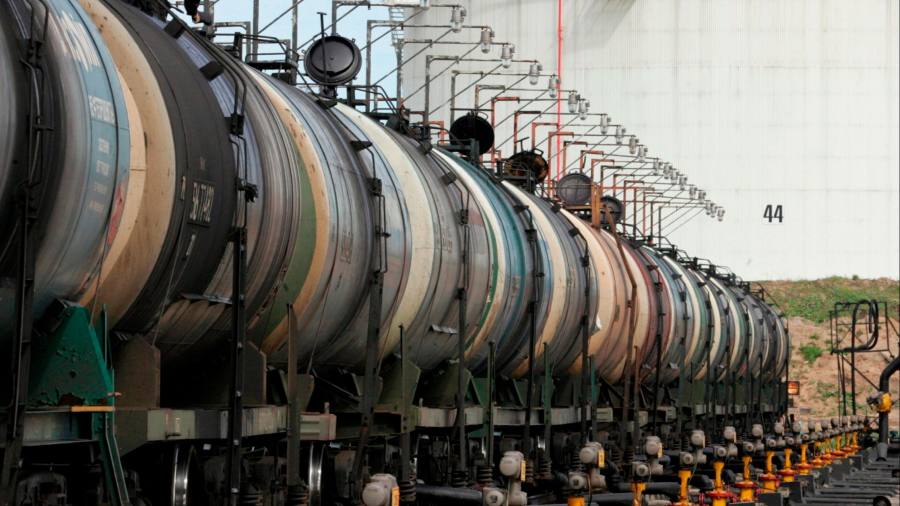Receive free Russian business & finance updates
We’ll send you a myFT Daily Digest email rounding up the latest Russian business & finance news every morning.
Talking to sanctions officials across Europe, the word of the moment is “attestation” — the term used for a vital piece of compliance paperwork required when shipping Russian oil. There is a growing sense that tinkering with the administration of the price cap can make it bite harder.
To take a quick step back: the price cap is a set of measures that prevent people or companies from participating countries from touching Russian oil unless it is sold below a ceiling. It aims to keep Russian oil flowing to the world while trying to squeeze the Kremlin’s finances.
The policy — introduced by the G7, the EU and Australia — has had more effect on some routes than others. The flows from the Russian far east to China have, for example, long been priced above the cap, which stands at $60 per barrel for crude. The price cap coalition has little traction there.
But oil coming out of the Russian Baltic ports, such as Primorsk and Ust-Luga, has been sold at hefty discounts. Pressure from the big buyers in India, who worry about flouting US sanctions, and the need for western ships and shipping insurance kept the discounts pretty steep.
But some of the downward price pressure there was overstated by a wheeze. Imagine I want to buy Russian oil for $65 a barrel and plan to sell it for $75 to a refiner in India — and let us say the refiner’s bankers are worried about the price cap. I can reorganise the deal such that the oil price is, say, $58 a barrel, but I seemed to spend $17 on shipping. That would get me past the price cap. We wrote about some of these schemes earlier this month.
In the past fortnight there have been hints that this sort of scheme may be stepping up a gear. Over the summer, the global rise in oil prices dragged Russian prices up with them. By mid-July, Argus, the pricing agency, started to quote spot prices of Urals and ESPO crude above $60 per barrel everywhere, even in those Baltic ports.
But here is a thing: customs filings made to the Russian authorities in July for shipments from the Baltic ports to India do not show any declarations above $60. A gap between the Argus data and the customs data opened up in late July just as the Argus price headed north of the cap.
This might all be innocent; the data is not measuring the same thing. It diverges often. The Argus data is a pricing estimate for the spot market and is based on traders’ assessments. Euan Craik, head of Argus oil market services, explains: “We’ve got a contact book of people who will talk to us about the Urals FOB market. And on any given day, they’ll tell us what the prices are in the market.”
The customs data, meanwhile, is not merely the spot market: it includes shipments that may have been agreed a long time ago. There is also a timing problem: the dates given for the Russian customs data are unreliable, and often appear with a delay.
So treat this with caution, but here’s the thing: a marked divergence between the two data series as the pricing agency broke through the $60 mark is exactly what you would expect if there were widespread price-cap evasion going on.
That also makes sense of why, even when Argus is being told that the price for oil in Primorsk is about $70 a barrel, a sizeable flow is still being carried on western-insured vessels. This sort of evasion would enable them to use these ships.
Under the rules, insurers and shipowners are so-called tier 3 entities, meaning they are not expected to know any pricing information. Their duty is merely to gather an “attestation” that the oil is priced below the cap. But the attestation is empty. Here is some of the usual wording:
“The Assured . . . warrants that for any provision of services related to the maritime transportation of Russian origin oil or Petroleum Products by any party entitled to cover such transportation has been, is, and will be in compliance with the price cap policy.”
That is why sanctions officials are talking about attestation reform. To make it difficult to pull this ruse, shipowners and insurers need to be given enough pricing information to act as checks on these wheezes.
But to make attestations bite, you will also need guidance on what “normal” costs look like. There is at present no benchmark for when shipping costs go from being hefty to suspicious. Introducing guidance on that would also help Indian buyers of Russian oil to squeeze down prices.
The price cap is deeply flawed and full of holes. But it has forced Russia to offer costly discounts to India, in particular, at a time when it needs the cash for its continuing invasion of Ukraine. With a bit of reform to how it is implemented, it should be possible to make those transfers a bit larger and more painful.
Other readables
Read the full article here



